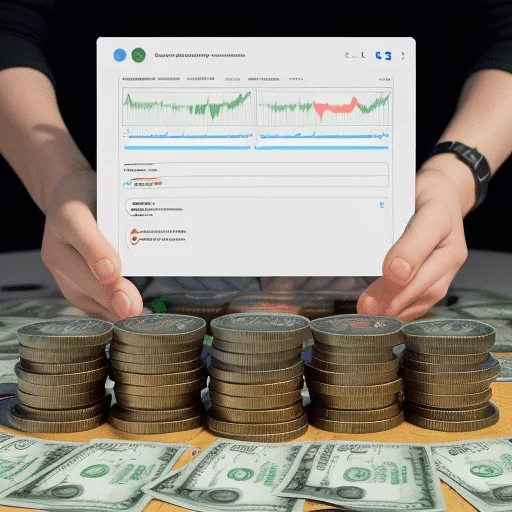The world of stock trading and the potential of making a significant income from the comfort of my own home has always fascinated me. However, there’s no denying that venturing into the stock market can seem intimidating, especially for those who are just starting out.
As I began my journey, I realized I needed a simple goal in mind–and that’s when I focused on making $200 a day through day trading. Making $200 a day may seem like a lofty goal at first, but with the right tools, strategies, and mindset, it’s entirely attainable.
In this article, I’ll walk you through the steps I took to become the trader I am today, from understanding the type of trader I wanted to be, to equipping myself with the knowledge and skills necessary for successful day trading. Together, we’ll explore how to curate a list of high-potential stocks, blueprint your path to success, and even test the waters with paper trades before investing real money.
So, let’s get started on this exciting journey towards mastering the art of day trading and making $200 a day!
Key Takeaways
- Understanding the type of trader you aspire to be is important
- Effective risk management is essential to protect your capital
- Equipping yourself with the knowledge and skills for successful day trading
- Focusing on stocks with consistent liquidity and strong volatility is key for day trading
Understanding the Type of Trader You Aspire to Be

As I begin my journey to make $200 a day in trading, I’ll need to explore different strategies, from day trading to swing trading, to find the best fit for my style.
It’s important for me to set realistic expectations and define my financial goals to stay focused on success.
To protect my hard-earned capital, I must create a solid risk management plan that helps me stay disciplined in my trading decisions.
I must also stay aware of the type of trader I aspire to be, as this will inform the strategies I use and the risks I will take. It’s important to remember that trading involves both gains and losses, and the key to success is staying disciplined and sticking to my plan.
Explore Different Strategies, from Day Trading to Swing Trading
Ready to explore different strategies for making $200 a day? Well, buckle up because I’m about to share some key points that will help you unlock that door to financial success. Let’s dive into the world of trading and discover that there’s more than one way to make a pretty penny.
- Day trading: This fast-paced approach involves buying and selling stocks within the same day, capitalizing on small price movements to make dollars a day.
- Swing trading: A bit more relaxed, swing trading focuses on capturing gains over a few days or weeks, allowing you to better manage risk and take advantage of market trends.
- Trading strategies: To become a master trader, you’ll need to develop and fine-tune your own unique strategies, combining technical analysis, risk management, and market psychology.
- Risk management: Regardless of the trading style you choose, effective risk management is essential to protect your capital and keep your profits flowing.
While you absorb these strategies and techniques, it’s important to remember that the road to making $200 a day won’t be a straight one. So, as we continue this journey, let’s talk about setting realistic expectations and defining your financial goals.
Set Realistic Expectations and Define Your Financial Goals
Before diving headfirst into trading, it’s crucial for you to set realistic expectations and define your financial goals, ensuring you’re aiming for steady progress rather than overnight success.
While the idea of making $200 dollars a day through day trading or other trading strategies might sound appealing, it’s important to remember that trading is a marathon, not a sprint. You’ll likely encounter losses along the way, so it’s essential to clearly understand what you want to achieve and how much time and effort you’re willing to invest.
By setting realistic expectations and aligning them with your financial goals, you’ll be better equipped to navigate the difficulties of the trading world.
With your goals in mind, it’s time to create a risk management plan to protect your capital and maximize your potential for success.
Create a Risk Management Plan to Protect Your Capital
Crafting a risk management plan is like building a safety net for your finances, ensuring you’re well-prepared to handle any potential losses and safeguard your hard-earned capital.
When I’m day trading stocks, I know losing trades is inevitable, but having a solid risk management plan in place helps me minimize those losses and make smart decisions to protect my capital.
By setting stop-loss orders, determining my risk-reward ratio, and diversifying my portfolio, I follow these trading tips to avoid putting all my eggs in one basket. This way, I can confidently work towards making $200 a day, knowing that I have a safety net in place.
Now, it’s time to equip myself with the knowledge and skills for successful day trading to truly maximize my profits.
Equip Yourself with the Knowledge and Skills for Successful Day Trading

Before diving into the world of day trading, I need to ensure I’m well-equipped with the knowledge and skills to succeed. This includes mastering stock market terminology and mechanics, understanding the importance of technical analysis and chart patterns, and studying the impact of market news and economic events on stock prices.
By doing so, I’ll increase my chances of consistently making profitable trades and reaching my goal of earning $200 a day.
Learn the Basics of Stock Market Terminology and Mechanics
To successfully navigate the stock market and make $200 a day, it’s essential to understand basic terminology and mechanics, such as stock prices, market trends, and trading strategies. Familiarizing yourself with these concepts will empower you to make informed decisions when day trading, helping you achieve your financial goals. To get started, let’s look at some key terms and concepts often used in the stock market:
| Term | Definition | Example |
|---|---|---|
| Stock Price | The cost of a single share of a company’s stock | $50 per share |
| Market Trend | The general direction in which the stock market is moving | Bullish (upward) or Bearish (downward) |
| Trading Platform | A software or application used for trading stocks, options, and other financial instruments | E-Trade, TD Ameritrade |
| Trading Strategies | Techniques used by traders to buy and sell stocks in order to make profits | Swing trading, Scalping |
| Day Trading | The practice of buying and selling stocks within the same day, taking advantage of small price fluctuations | Buying 100 shares at $50 and selling them at $52 |
By mastering these basics, you’ll be better equipped to navigate the world of day trading and make the most of your trading platform. Now that you’re familiar with the fundamentals, it’s time to dive deeper into the world of technical analysis and chart patterns that can further enhance your trading skills.
Understand the Importance of Technical Analysis and Chart Patterns
You’ll really boost your trading game by diving into technical analysis and chart patterns, which are crucial tools for predicting future price movements and spotting profitable opportunities. By mastering these skills, you can harness the power of stock charts and price action to become a top-notch day trader.
Just imagine being able to:
- Identify key support and resistance levels that can determine entry and exit points for your trades
- Recognize classic chart patterns like head and shoulders, double tops, and triangles that signal potential breakouts or reversals
- Use technical indicators like moving averages, RSI, and MACD to gauge market momentum and trends
- Combine multiple technical analysis tools to create a robust trading strategy that can help you consistently generate $200 or more per day
As you continue to sharpen your understanding of technical analysis and chart patterns, make sure to also study the impact of market news and economic events on stock prices. This will enable you to make more informed trading decisions and take advantage of market opportunities.
Study the Impact of Market News and Economic Events on Stock Prices
Staying in tune with market news and economic events is essential for staying ahead of the game in day trading, as it can impact stock prices and open up lucrative opportunities. By closely studying the effects of market news and economic events on stock prices, I can better understand the forces that drive market movements and make informed decisions on my trades.
This knowledge allows me to capitalize on sudden market shifts and swiftly seize high-potential opportunities. To truly master this skill, I must stay up-to-date with financial news sources, economic calendars, and relevant industry happenings.
Armed with this information, I can then navigate the market with an astute eye, making it significantly easier to curate a list of stocks with high-potential trading opportunities.
Curate a List of Stocks with High-Potential Trading Opportunities

As a day trader, I focus on stocks with consistent liquidity and strong volatility. This is crucial for identifying high-potential trading opportunities.
To find these gems, I screen for trending industries, sectors, and penny stocks that have the potential to generate significant profits.
By monitoring my watchlist regularly, I stay ahead of market shifts and seize opportunities as they arise.
I adjust the paragraph structure in my research notes to logically group complete sentences on their own lines, with a double new line after each group. This makes it easier for me to quickly scan through the information and find the most promising stocks.
I also use contractions to make my notes more concise and readable. This helps me stay focused and make informed trading decisions.
Focus on Stocks with Consistent Liquidity and Strong Volatility
Aiming for stocks with consistent liquidity and strong volatility can significantly boost your daily earnings, making that $200 target much more attainable.
To achieve that, you must apply effective day trading strategies that focus on identifying stocks with high liquidity and volatility. Liquidity ensures you can enter and exit positions easily, while volatility offers the price fluctuations needed for profit. Here’s a quick table to help you understand the importance of these factors:
| Factor | Importance in Day Trading | How to Identify |
|---|---|---|
| Liquidity | Easy entry/exit | High trading volume |
| Volatility | Profitable price movements | Price fluctuations |
| Consistent Stocks | Predictable patterns | Technical indicators |
By mastering the art of selecting stocks with these characteristics, you’ll increase your chances of success in the world of day trading. Now, let’s move on to screening for trending industries, sectors, and penny stocks to further expand your opportunities for consistent profits.
Screen for Trending Industries, Sectors, and Penny Stocks
Now that I’ve got a good grasp on focusing on stocks with consistent liquidity and strong volatility, it’s time to take it a step further and screen for trending industries, sectors, and penny stocks.
This can really help me make that 200 dollars a day I’m aiming for. To do this, I’ll monitor the news, social media, and financial websites to identify which industries and sectors are gaining momentum.
By investing in penny stocks from these trending industries, I might capitalize on the growth and increase my chances of making significant returns. However, it’s important to remember that penny stocks come with their own set of risks, so I’ll need to do thorough research before making any investments.
With a watchful eye on market trends, I’ll be much closer to achieving my goal. In order to stay on top of these trends and capture market shifts, I’ll need to monitor my watchlist regularly.
Monitor your Watchlist Regularly to Capture Market Shifts
In order to stay ahead of the game and capitalize on lucrative opportunities, it’s essential to regularly monitor my watchlist. This allows me to catch market shifts and swiftly adapt my investment strategy. By keeping a close eye on my carefully curated list of stocks, I can identify trends and changes in their performance. This ensures that I’m always in the best position to make informed decisions and work towards my goal of making 200 dollars a day.
As the market is always evolving, staying up-to-date with the latest developments and being prepared to adjust my approach accordingly is crucial. By diligently tracking these market shifts, I can optimize my stock trading strategy and set myself up for continued success.
Now, let’s dive into creating a blueprint for reaching that $200-a-day milestone in the world of stock trading.
Blueprint Your Path to $200-a-Day Success in Stock Trading
Embarking on my journey to make $200 a day in stock trading, I’ve realized the importance of outlining simple entry and exit rules for every trade. I need to incorporate risk management strategies like stop-loss orders and be prepared for various market scenarios.
Not only that, but I also need to revise my trading plan periodically to stay on top of my game.
Let’s dive into these key points and blueprint my path to success in stock trading!
Outline Simple Entry and Exit Rules for Every Trade
To maximize your daily earnings, it’s crucial to establish simple entry and exit rules for each trade, ensuring you stay disciplined and focused on your strategy. The world of day trading can be chaotic, but having a well-defined plan can be the difference between success and failure.
Your entry and exit rules should be based on technical analysis, market trends, and personal risk tolerance. For instance, set a profit target, such as a specific percentage gain, and a stop-loss order, to limit potential losses. This way, you’ll have a clear guide to follow, allowing you to make informed decisions and avoid impulsive, emotion-driven trading.
As you become more adept at recognizing profitable opportunities, refining your entry and exit rules will become second nature, leading you closer to that coveted $200-a-day goal.
Now that you’ve got your rules in place, let’s move on to incorporating risk management strategies, such as stop-loss orders, to further secure your success.
Incorporate Risk Management Strategies, such as Stop-Loss Orders
By embracing risk management strategies like stop-loss orders, you’ll be well on your way to safeguarding your hard-earned profits and inching closer to your daily earnings goal.
Implementing stop-loss orders in your day trading plan is crucial in preventing emotions from getting the best of you and causing impulsive decisions. These orders help ensure that you automatically exit a trade when the price reaches a predetermined level, limiting your losses and protecting your profits.
By consistently incorporating risk management strategies into your trading plan, you’ll not only mitigate potential financial damage but also foster the discipline and objectivity needed to thrive in the unpredictable world of day trading.
Now that you’ve got a handle on minimizing losses, it’s time to focus on adapting to various market scenarios and periodically revising your trading plan to stay ahead of the game.
Prepare for Various Market Scenarios and Revise Your Trading Plan Periodically
Adapting to different market scenarios and regularly updating your trading plan is essential for staying ahead of the curve and maximizing your success in day trading. To potentially make money and reach the goal of $200 a day, you need to prepare for various market scenarios and revise your trading plan according to current market conditions. A solid trading approach should involve flexibility and adaptability. To illustrate this, let’s look at the following table:
| Market Condition | Trading Strategy |
|---|---|
| Bullish | Long positions, buying on dips |
| Bearish | Short positions, selling on rallies |
| Sideways | Range trading, support and resistance levels |
| High Volatility | tight stop losses, smaller position sizes |
By considering different market conditions and adjusting your trading approach, you can maintain a competitive edge and increase your chances of success in the long run. Now that you’ve got a grasp on adjusting to different market scenarios, it’s time to test the waters with paper trades before investing real money.
Test the Waters with Paper Trades Before Investing Real Money

Before I dive into the world of stock trading and aim for that $200-a-day success, I’ll need to test the waters with paper trades.
By opening a demo trading account, I can gain hands-on experience, analyze my performance metrics to identify strengths and weaknesses, and seek feedback and mentorship from experienced traders in my network.
This way, I can build a solid foundation before investing real money.
Open a Demo Trading Account to Gain Hands-On Experience
Diving into the world of demo trading accounts is like testing the waters before plunging into the deep end, allowing you to gain valuable hands-on experience of making $200 dollars a day. By opening a demo trading account, you can practice your day trading strategies without risking your hard-earned money. This is an excellent way for beginner day traders to learn the ropes, as it provides a realistic simulation of the market and trading conditions. Here’s a comparison of two popular demo trading platforms:
| Platform | Pros | Cons |
|---|---|---|
| Platform A | User-friendly interface, wide range of instruments | limited technical analysis tools |
| Platform B | Advanced charting and analysis tools, customizable interface | Steeper learning curve |
As a day trader, it’s crucial to choose the right trading account that suits your needs and preferences. Take the time to explore different platforms and assess their features, ease of use, and overall performance. And remember, practice makes perfect—the more hands-on experience you gain, the better equipped you’ll be to make that $200 a day. Now that you’ve got your demo account up and running, it’s time to analyze your performance metrics to identify your strengths and weaknesses.
Analyze Your Performance Metrics to Identify Your Strengths and Weaknesses
It’s essential to scrutinize your performance metrics, as this’ll help pinpoint your strengths and weaknesses, ultimately shaping you into a more proficient day trader.
Analyzing your performance metrics involves examining each trade, identifying patterns, and evaluating whether your trading strategies are working or if you’re setting unrealistic profit targets. By understanding your strengths and weaknesses in day trading, you can make informed decisions to refine your approach, enabling a more successful trading career.
As you continue to grow and develop your skills, seeking feedback and mentorship from experienced traders in your network becomes a valuable resource in your journey to making $200 a day.
Seek Feedback and Mentorship from Experienced Traders in Your Network
As you strive to improve your trading skills, seeking feedback and mentorship from experienced traders in your network is crucial.
In fact, a study found that 53% of successful traders attribute their success to mentorship, highlighting the value of learning from others in your journey to consistent profits. Becoming a good trader takes time, effort, and the willingness to learn from others who have already walked the path you’re on.
Engaging with experienced traders in your network, analyzing their strategies, and applying their insights to your own trading can help you reach your goal of making $200 a day. Don’t be afraid to seek feedback and ask questions, as this will only strengthen your skills and understanding of the market. To get started, consider reaching out to the following individuals in your network:
| Experienced Traders | How They Can Help |
|---|---|
| Successful day traders | share their strategies, risk management techniques, and market insights |
| Trading mentors | Offer personalized guidance, help identify strengths and weaknesses, and provide ongoing support |
| Financial advisors | Provide expert advice on portfolio management and investment strategies |
| Trading community members | Exchange ideas, discuss market trends, and learn from collective experiences |
By leveraging the expertise and experience of others in your network, you’ll be well on your way to becoming a more confident and profitable trader.
Frequently Asked Questions
How long does it typically take to reach the goal of making $200 a day, and how consistently can this be achieved?
Reaching the $200 a day goal might take some time, but it’s achievable with dedication and strategy. Consistency depends on the chosen method and your ability to adapt and master the required skills. Keep at it!
What are the tax implications of making $200 a day through day trading, and how should traders prepare for these responsibilities?
Day trading taxes can be tricky! As a day trader, you’ll likely face short-term capital gains taxes, which have higher rates. To prepare, track profits diligently and consider working with a tax professional. Don’t worry, you got this!
Are there any specific trading platforms or tools that are helpful for achieving the $200-a-day goal?
Want to boost your trading game? I recommend platforms like eToro or Robinhood, which offer user-friendly interfaces and advanced tools. With practice, you’ll be making that $200-a-day goal in no time!
How much starting capital is recommended for someone aiming to make $200 a day through day trading?
To make $200 a day through day trading, I’d recommend starting with at least $5,000 to $10,000 in the capital. This way, I can manage risk effectively and have enough room to make profitable trades consistently.
How can one manage the emotional and psychological aspects of day trading, such as dealing with losses or maintaining discipline in sticking to their trading plan?
To manage emotions in day trading, I practice mindfulness, accept losses as part of the process, and stay disciplined by sticking to my trading plan. Journaling my thoughts also helps me to reflect and improve.
Conclusion
In the end, navigating the stock market is like sailing through a stormy sea. You need to have the right tools, knowledge, and strategy to make it to your destination and achieve that $200 a day goal.
Remember, practice makes perfect. Keep refining your skills and strategies, learn from your mistakes, and stay persistent.
With time and dedication, you’ll find your way to that financial island paradise you’re aiming for.




